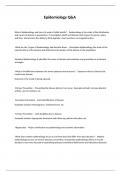Exam (elaborations)
Epidemiology Q&A
- Course
- Epidemiology
- Institution
- Epidemiology
What is Epidemiology and how is it used in Public Health? - Epidemiology is the study of the distribution and causes of disease in populations. It investigates health and disease with respect to person, place, and time. And involves the ability to think logically, count and have an imaginative ide...
[Show more]



